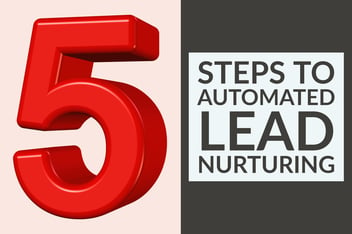10 Steps To Inbound Marketing Campaigns (And 20+ Tools To Complete Them)
.png?width=550&name=10%20Steps%20To%20Inbound%20Marketing%20Campaigns%20(And%2020+%20Tools%20To%20Complete%20Them).png)
Are you looking for a way to generate qualified leads that doesn’t involve cold calls, mass mailings (digital or print), or a heavy investment in paid advertising? Maybe a strategy that will not only provide leads, but also establish your company as a thought leader in your industry and a trusted source of information for current customers and prospects alike?
That is what inbound marketing can do. And often for a lower cost-per-lead than traditional outbound marketing. So, what do you need to do to create your first inbound marketing campaign?
Let’s walk through the highlights — with plenty of links to get you details and tools for each step along the way.
1. Identify your campaign audience.
For each campaign you create, you need to know who you are trying to reach. You may have different campaigns for the same brand, but with each focused on a specific audience. That could mean marketing your product differently based on geography, or taking a different approach to reach a different age group, or focusing on different features depending on whether you are targeting the decision maker or the end user in a B2B campaign.
In order to target a campaign effectively, develop complete customer personas for each audience you want to reach. Buyer personas are fictionalized, generalized representations of your ideal customers that help you understand your customers (and prospective customers) better, and make it easier to tailor content to the specific needs, behaviors and concerns of different groups.
Tools to help you identify your audience and develop customer personas:
2. Set your goals and benchmarks.
Know what the campaign is intended to achieve. Is it meant mostly to increase awareness and drive website traffic? Does it need to bring in a certain number of new leads to support corporate goals? What marketing metric targets will you need to hit in order to reach revenue goals?
SMART goals (specific, measurable, achievable, relevant and time-based) should be a part of every campaign, providing you with both a roadmap to what you want to achieve and a benchmark to measure against to determine success.
Research has shown that marketers who set goals are more than four times as likely to report to success as those who don’t. (See more.)
Tools for setting campaign goals:
3. Plan and create campaign content for all stages of the sales funnel.
I mentioned above that marketers who set goals are four times as likely to report success. In addition to that, those who have documented strategies are five times more likely to report success in their campaigns.
Taking the time to write out both an overall marketing strategy document, and plans for each specific campaign, pays off.
Your campaign plan should include offers that will entice website visitors to convert into leads to access them. Inbound marketing offers can range from simply subscribing to an email newsletter to downloading a coupon, starting a free trial, viewing a webinar or accessing a detailed case study. You will want to plan offers that appeal to all stages of the sales funnel, from awareness to consideration and decision.
(Check out this blog post for 25 possible inbound marketing offers you could use, reaching buyers at all stages of the sales funnel.)
When it comes to creating content, our best advice is this: Don’t just delegate content creation to the newest member of the team. Find good writers (or video producers or designers) and give them the time and tools they need to do great work. Quality content matters.
Tools for planning and creating campaign content:
4. Create calls-to-action and landing pages.
Among the building blocks of your campaign, which are essential in linking visitors to the great offers you created and converting them into leads, are calls-to-action and landing pages.
Calls-to-action are the attention-grabbers that link to landing pages. These can be in the form of banner or sidebar ads and other images, explicit written links to landing pages such as saying “Download our campaign planning template here!,” or more subtle in-text hyperlinks to a related offer from a word or phrase in a blog post, email, or even in a downloadable file.
When a website visitor or email recipient or social media follower clicks on that call-to-action (also called a CTA), they are linked directly to a landing page, where by filling out a form, they gain access to the offer.
Landing pages should have a single purpose: Encourage the visitor to fill out a form and convert into a lead. Creating landing pages that convert means paying attention to how you use text, video, images, and a form that doesn’t intimidate or turn visitors away.
Tools for creating calls-to-action and landing pages:
5. Plan and create automated lead nurturing workflows.
So, what happens once a visitor converts into a lead on your website? They should be automatically enrolled into a lead nurturing workflow. This series of emails is designed to offer leads additional content and establish a connection that can guide them through the sales funnel toward a purchase decision. Automated workflows can be created through inbound marketing software such as HubSpot, which manages content, leads, and customer relationship management. (Wondering what it takes to get started on inbound marketing with HubSpot? Check out our implementation timeline for details.)
Workflows should be based on the lead’s stage in the sales funnel, providing more general information to those still in the awareness stage, and becoming more specific to your products or services as they near a decision.
Tools for planning and creating automated lead nurturing workflows:
6. Write blog posts related to your campaign offers.
In order to bring visitors to your website, where they can see the CTAs and convert on landing pages, you will need to provide a reason for them to be there. One of the most compelling reasons for visitors to come to your website is content. And one of the best ways to provide a steady source of content is through a business blog.
Blogs should focus on the same topics as your offers — providing information, education or entertainment that helps customers solve their problems. A business blog should NOT focus primarily on selling your product.
For example, if you are creating a business blog for a bank, consider writing blog posts about how consumers can save for a goal (home down payment, new car, college, etc.) by making small changes in spending and putting the extra funds away in a dedicated account. Don’t just write posts about how much interest is paid on your money market accounts or the new checking account features you’ve added. Some product news is OK, but make the focus on helping your customers address their needs, relevant to your products. And then use your blog posts to link to the offers where visitors can be converted into leads.
As you add to your blog, your website is more likely to turn up in search results, bringing organic traffic to the site. Vary your blog posts to reach readers with different priorities and content preferences.
Tools for writing blog posts:
7. Use social media and other channels to promote blog posts and offers.
Once your blog posts are written, you will need to promote them more to reach as many potential customers as possible. One key place to promote your blog posts is on social media. Develop a consistent strategy for sharing blog posts across your social media platforms, not only on the day the post is first published, but a few days, weeks or even months later — by writing evergreen blog material, you can continue to promote it and gain website visitors and leads long after the original push date.
You can also use social media to directly promote your offers, linking from social media posts directly to the landing pages, but be sure to balance these calls-to-action with useful, useable content for your social media followers that isn’t a direct call for a sale or commitment.
Email is also a great way to promote your business blog, both through subscriptions for regular email updates (you can subscribe to the Inbound Accelerator here) and by incorporating links to blog posts in other emails. This can include your lead nurturing emails, emails from account representatives to prospects they are working with, or even as a link in email signatures from everyone in your company.
Tools for using social media and other channels:
8. Optimize for search.
This may be listed as #8 on this list, but it really should be a part of each of the steps above as you identify a target audience or buyer persona, plan the campaign, and create all of the content, including offers and blog posts. From the beginning, think about what your target audience is looking for and what search terms they are most likely to use.
Create all of your content with those terms or problems in mind. Then focus on including them not only in the text of your content (which should be written for readers, not just the search engines), but also in specific places on your web page. Those other places include in image file names and alt text, within headers and page titles, and in the meta descriptions and schema included in the infrastructure of your page.
Tools for search optimization:
9. Track and analyze campaign metrics.
So you’ve planned, created and launched your campaign, and now it’s time to sit back and watch the leads roll in, right?
Wrong! Now it’s time to start tracking how well each part of your campaign is performing and analyze the metrics so that you know what is working well and what needs to be tweaked. Alongside your normal marketing metrics, such as website traffic and the conversion rate on your landing pages, be sure you are keeping track of the kinds of bottom line metrics your boss really wants to know, like how much each marketing-acquired customer (as opposed to a sales-acquired customer landed through cold calls) costs.
Dig deep into your blog’s metrics to look for ways of making your blog better. (If you are using HubSpot, click here for an in-depth look at all the data HubSpot can provide.) What topics get the most traffic? Which types of posts keep readers on the page longer? Which posts are most likely to lead readers to click on the CTA to a landing page for an offer?
Tools for tracking and analyzing metrics:
Use what you learn to make changes for your next campaign, because you know what Number 10 on this is going to be, right?
10. Do it again!
Exactly! One campaign is just the beginning. Inbound marketing is a long-term approach, and the campaigns you create now — offers, blog posts and nurturing workflows — can continue to bring in leads for years. But the best results come when you build on them month after month.
Inbound marketing campaigns have the potential to generate qualified leads for up to 60 percent less than traditional outbound marketing. Whether you are just getting started or have several inbound marketing campaigns under your belt, you can use our Rate Your Inbound Marketing Scorecard to evaluate your efforts and improve for the next round. Download it today.
-1.png?width=1652&height=294&name=Jones(RGB)-1.png)

.png)








.png?width=352&name=5%20Elements%20Of%20A%20Complete%20Marketing%20Content%20Package%20(video).png)

